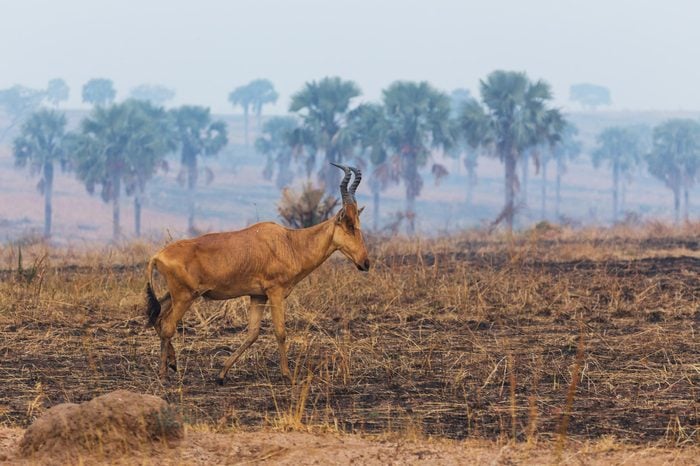
Saola (Pseudoryx nghetinhensis)
The Saola Working Group calls this ungulate native to the mountains of Laos and Vietnam one of the rarest large animals on Earth. Citing habitat loss and poor attention to its conservation as the primary threats to the saola’s existence, the Group, which strives to keep the species extant, also maintains that with proper care, its demise can be halted. The Saola is only one of 14 animals that could disappear in your lifetime.

Cuban snail (Polymita picta)
Collected to near-extinction by poachers seeking to sell them as jewelry, these large, vibrantly, and multi-colored land snails were listed as endangered in 2012. With eyes literally popping out of the end of long stalks on their heads, these hermaphrodites use their shells to attract mates. If only snails’ razor-sharp teeth were effective weapons against human threats.
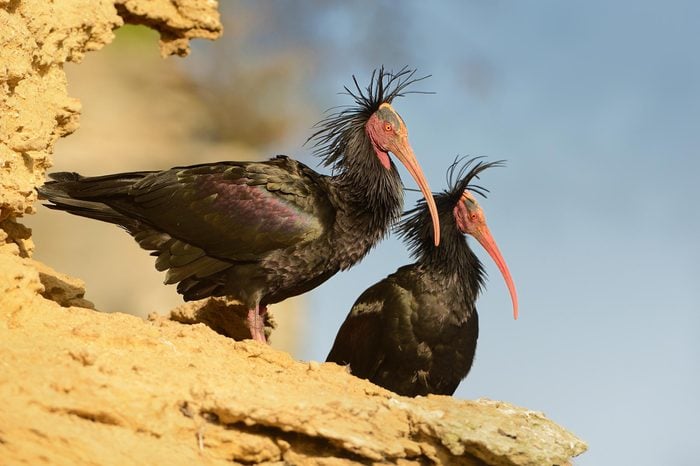
Northern bald ibis (Geronticus eremita)
BirdLife calls this large bird the rarest bird in the Middle East. Indeed, only 100 pairs remain in Morocco and there are a mere two pairs in Syria, although this is an improvement since the bird was presumed extinct in Syria until 2002. Desertification is the primary cause of its demise, although there are attempts to reverse this trend; their breeding area became protected in 2004, and many regional governments and NGOs have stepped in to work on conserving the Syrian population in particular. Here are 27 “facts” about animals you have all wrong.
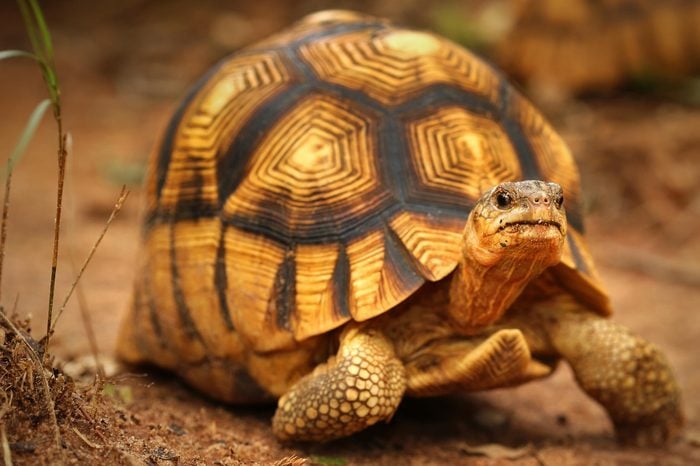
Ploughshare tortoise (Astrochelys yniphora)
With only a few hundred of these animals left in the wild in Madagascar, extinction for the world’s most endangered tortoise is predicted to occur within the next ten years. Luckily, efforts have ramped up to save it. The Turtle Conservancy and Durrell Wildlife Conservation Trust engage with local communities to help end poaching and to reclaim animals from illegal collections and place them in breeding programs. Some species of turtles are among the longest living animals on earth.
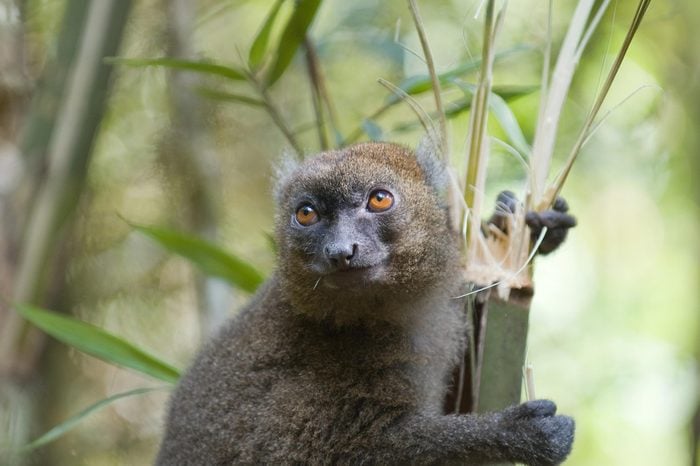
Greater bamboo lemur (Hapalemur simus)
Elsewhere in Madagascar, this five-pound primate with distinctive white ear tufts is down to a mere 500 individuals. Eating bamboo exclusively, like the panda, means that it’s been extremely susceptible to degradation and destruction of the rainforest in which it forages; it’s also been aggressively hunted. World Wildlife Fund (WWF) and other organizations are working to protect its habitat and discourage locals from hunting it.
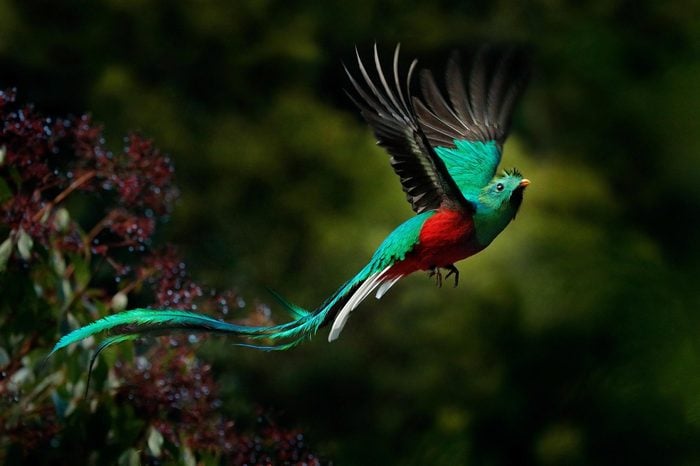
Resplendent Quetzal (Pharomachrus mocinno)
Numbers of these bright green-and-red birds with extravagant plumage are shrinking fast in their native Central American mountains; poaching for sale as pets and habitat loss are the main reasons. Once sacred to Maya and Aztec people, whose “royalty and priests wore its feathers during ceremonies,” according to National Geographic, their favor among eco-birders may help elevate their status locally and ultimately help to preserve them. These are the strangest animals found in each U.S. state.
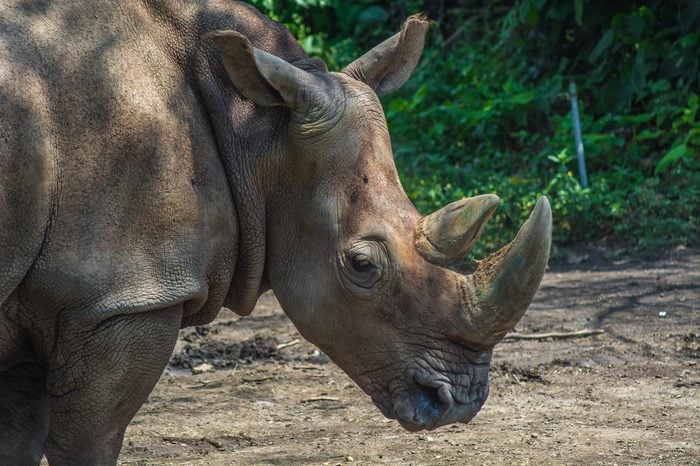
Sumatran Rhinoceros (Dicerorhinus sumatrensis)
This is the most diminutive of all rhino species (3-1/2 feet tall and a mere 1 ton), and the only one with two horns, and like most of its cousins, it is critically endangered. Two subspecies are barely holding on in Western and Eastern Sumatra, while a third is thought to have gone extinct, according to WWF. Sumatran Rhino Rescue is working to collect the 80 remaining, struggling, individuals from the wild and bring them to sanctuaries where they are safe from poaching and can be bred—efforts which would benefit all rhino species.
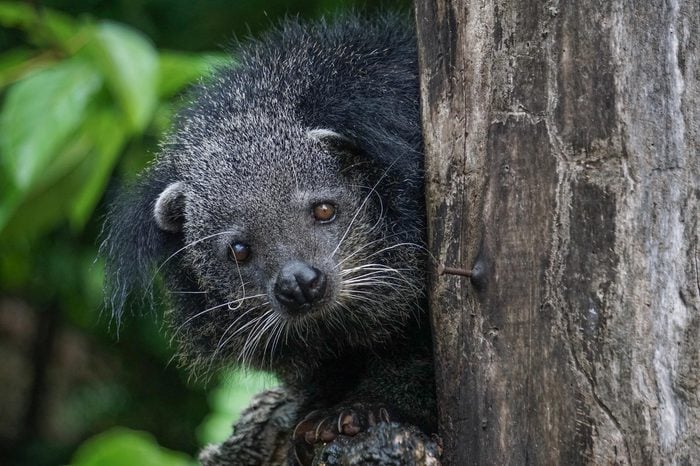
Bearcat (Arctictis binturong)
These nocturnal, slow-moving, mostly-fruit-eating carnivores that are closely related to civets make their homes in trees in south and southeast Asia. The San Diego Zoo lists them as vulnerable in some regions, endangered in others, due to poaching for the pet and traditional medicines trade, and for food. The Association of Zoos and Aquariums has developed a Species Survival Plan for the Bearcat, working to set up vital protections before it’s too late.
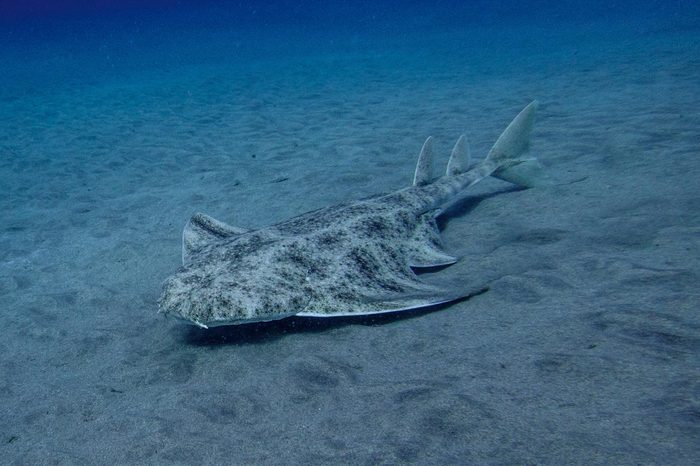
Angel shark (Squatina squatina)
Once widespread in the northeast Atlantic, Mediterranean, and elsewhere, the angel shark has seen its populations declining precipitously over the past 50 years. The fact that it’s easily caught up as bycatch in fishing nets, along with it low breeding rates, has boded poorly for its survival, especially in the last 15 years, in which brief time it’s gone from vulnerable to critically endangered. There are action recovery and regional management plans in place, so hopefully we can turn this trend around soon.
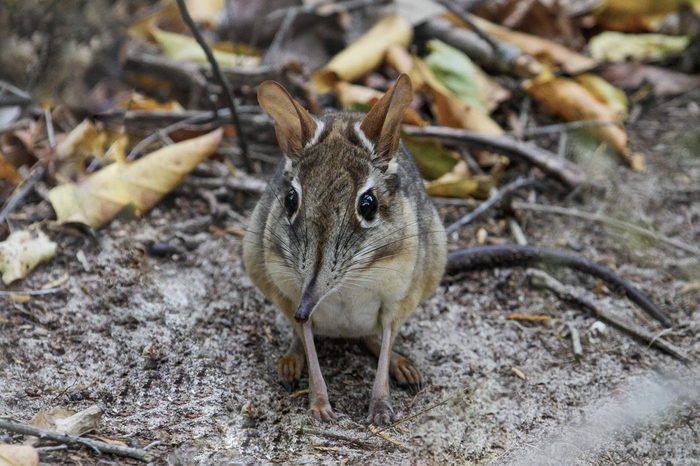
Golden-rumped elephant shrew (Rhynchocyon chrysopygus)
The golden-rumped elephant shrew of Kenya is considered the most endangered of four recognized species of giant elephant shrew. Endemic to coastal forests, which themselves are highly endangered due to development, some 13,000 of these small mammals are thought to remain in the wild. Sadly, there is no current monitoring of their population, nor legislation seeking to protect it.
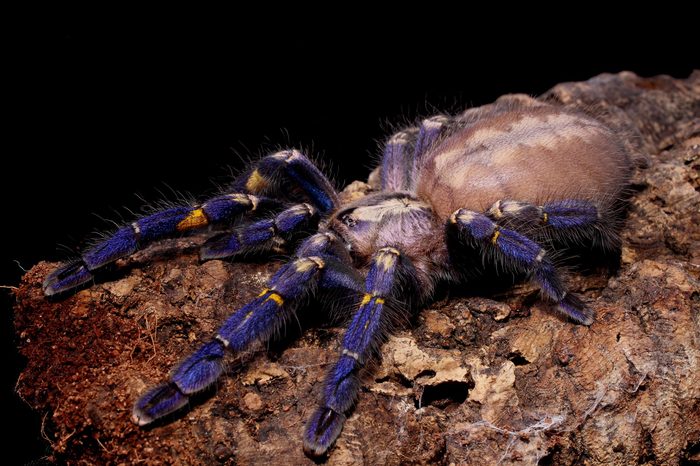
Peacock tarantula (Poecilotheria metallica)
War, civil unrest, and military exercises in western India have led to the steep decline of this the only blue species in its genus; it’s also actively collected for the pet market. No one’s sure how many of these spiders remain in the wild (although whatever the number, it’s presumed to be low). IUCN’s Red List entry for the species specifies that research, assessment, and a whole slew of conservation measures are needed to help the Peacock tarantula remain extant. You’ll gain a new respect for spiders after learning about 14 of the most elaborate spider webs found in nature.
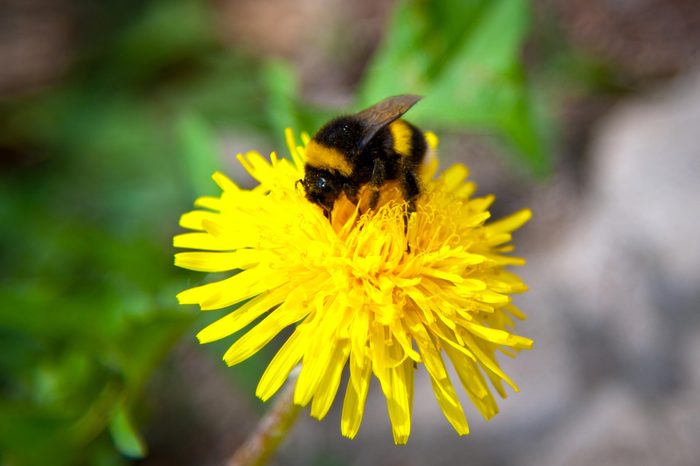
Rusty-patched Bumblebee (Bombus affinis)
On the brink of extinction for years, with its numbers depleted by 90 percent, this bumblebee species once common in over half of U.S. states was officially listed as endangered in 2017. It was the first-ever American bumblebee to achieve this unfortunate status, according to National Geographic; it joined seven species of Hawaiian yellow-faced bees in receiving federal protection.
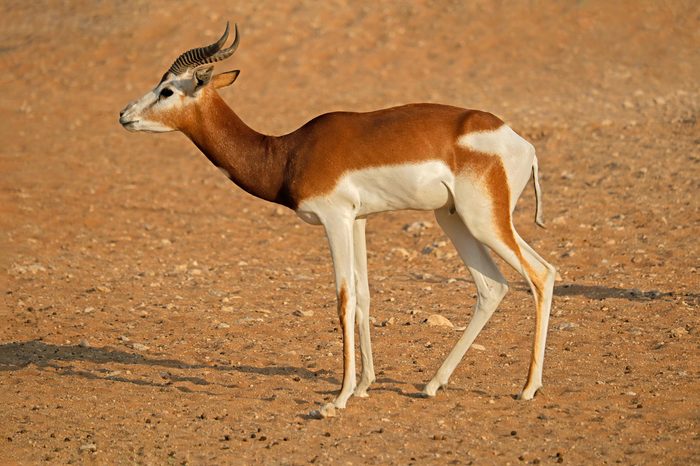
Dama gazelle (Nanger dama)
With Saharan grassland populations fractured and struggling to find enough to eat in order to persist, this small African antelope is represented by an estimated 100 individuals in the wild. The Sahara Conservation Fund, along with a number of zoos, is working to protect the animal in Chad, Niger, and Mali while running breeding programs with an eye toward reintroducing this large gazelle into the wild.
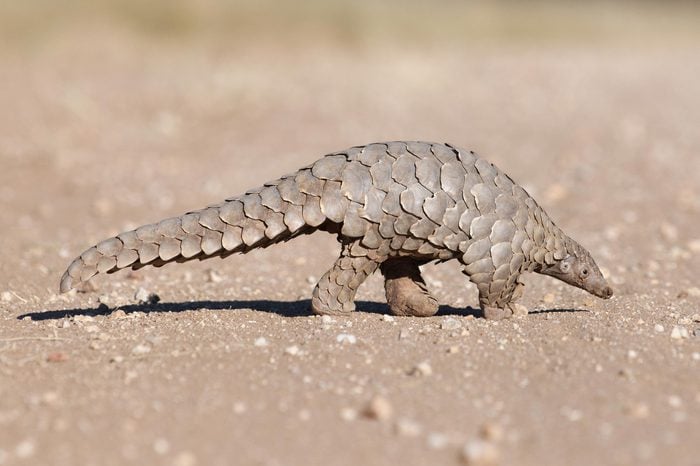
Pangolin
Of the eight species known to live in the wild—four in Asia and four in Africa—two are critically endangered and the rest are listed as at least vulnerable. These odd, quiet, armored animals are some of the most trafficked animals in the world, prized for their scales. All of them are currently protected by international law according to the WWF.
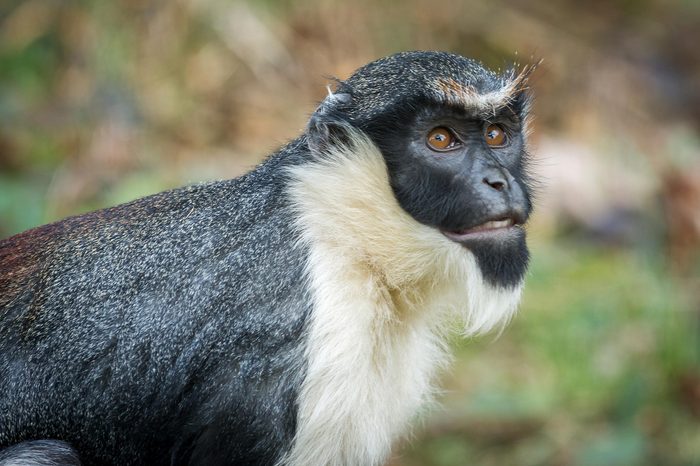
Diana monkey (Cercopithecus diana)
In Côte d’Ivoire, Guinea, Liberia, and Sierra Leone, populations of this striking black and white primate are in decline and experiencing “severe” fragmentation in its once abundant forests, according to the IUCN Red List. Civil unrest, logging, and hunting have led to its current “vulnerable” status, although the Roloway monkey (Cercopithecus diana roloway) of Ghana/Côte d’Ivoire is edging near to extinction.
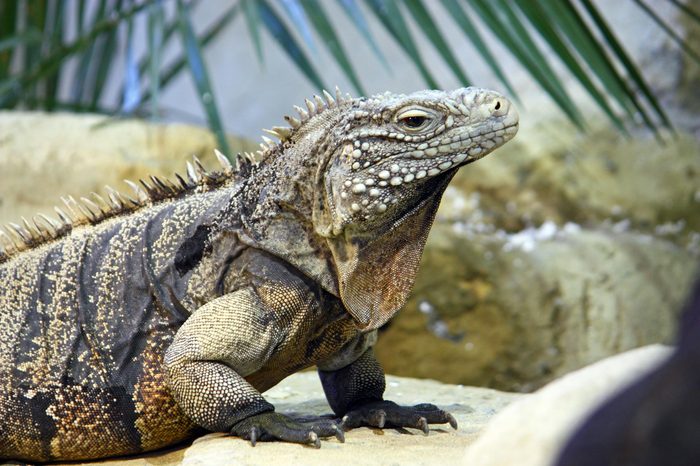
Cuban rock iguana (Cyclura nubila)
Although related species of rock iguana are threatened around the globe, this five-foot, 15-pound iguana native to the island of Cuba has yet to reach that status—thankfully. However, habitat loss and predation from dogs, cats, and feral pigs are creating a hostile environment that might soon lead to population declines. A program at the San Diego Zoo is renowned for its rock iguana breeding program. These are the 12 things you didn’t know lizards could do.
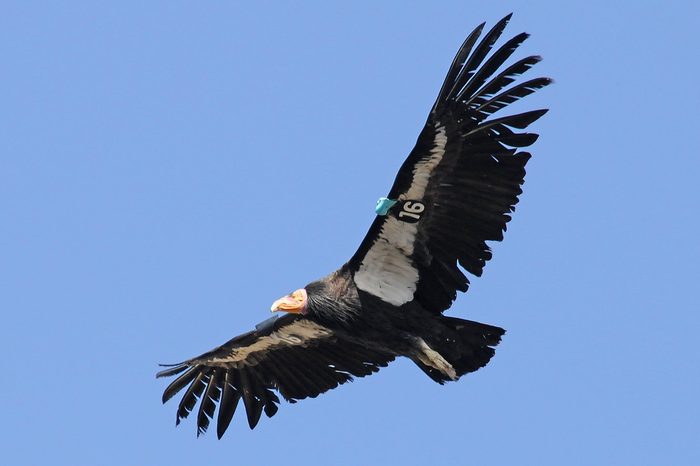
California Condor (Gymnogyps californianus)
America’s largest bird was pushed to near-extinction from hunting of the bird itself—and of other animals (many bullets contain lead, which remains in the carcasses these cliff-nesting vultures feed on, then poisons them). Numerous efforts have been put in place to bring it back from the brink; it’s now illegal to use lead ammunition in the state of California, for example. From 25 wild condors in 1975 to more than 500 in the world in 2019, slowly this bird is recovering. And although conservation news is often grim, these 15 other species are coming back from the brink of extinction, too.
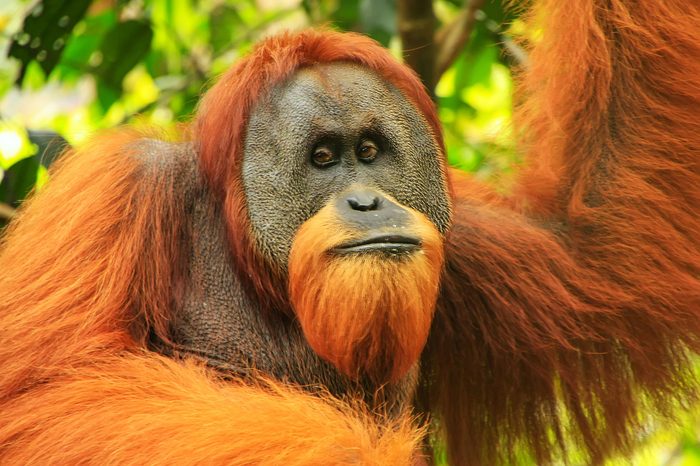
Sumatran orangutan (Pongo abelii)
It’s tough times for primates, which are suffering from critical losses of the forests they call home. This subtropical orangutan is no different; there are now only nine populations of them living in what’s left of Sumatra’s forests (much of it has been lost to fire and conversion to palm oil plantations), and a little over 14,000 individuals remain. Plans to build a big new road presents another threat to their continued viability; The WWF is working with companies and governments to preserve what forest is left.
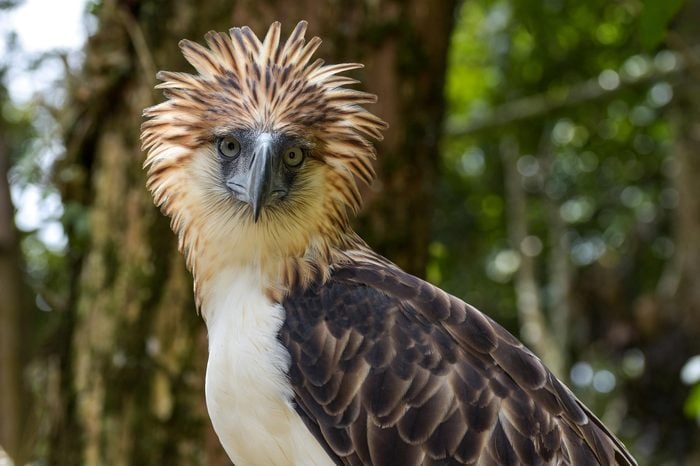
Philippine eagle (Pithecophaga jefferyi)
The Philippine Eagle Foundation calls this raptor one of the rarest birds in the world, with populations remaining on only four of the country’s 7,000+ islands. Somewhere between 180 and 500 birds exist in the wild, and the fact that they need as many as 11,000 hectares of forest on which to hunt—forest that is rapidly dwindling—means the fight to preserve them is up against significant challenges.
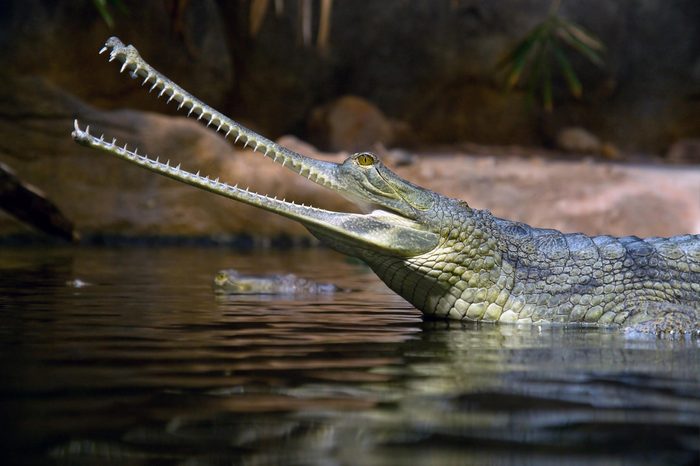
Gharial (Gavialis gangeticus)
This one ton top predator is surprisingly vulnerable to hunting and the dire changes to its freshwater habitats, that it’s experienced a devastating 98 percent decline in its populations—which less than 100 years ago were abundant from Pakistan to Myanmar. Programs where the crocodilian continues to exist in low numbers (India and Nepal), have been instituted to research methods for conservation and to work with local community groups.
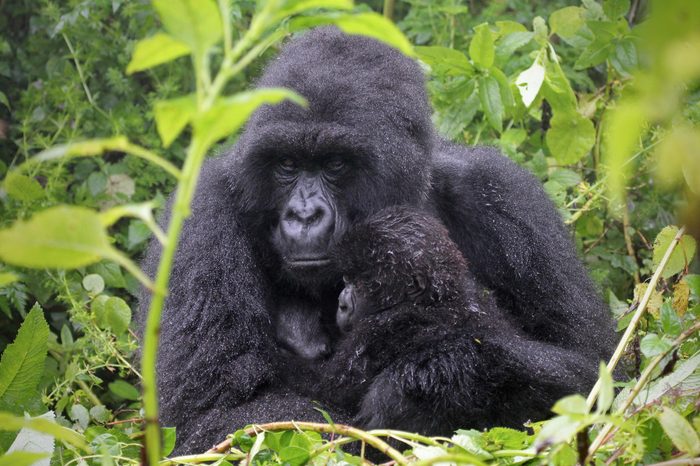
Mountain gorilla (Gorilla beringei beringei)
Dian Fossey made the study of, and advocacy for, this majestic, thick-furred primate her life’s work; nevertheless, for all the efforts she and others made over the years, the mountain gorilla of the Democratic Republic of Congo, Rwanda, and Uganda is critically endangered. The WWF reports that thanks to recent conservation efforts, some strides have been made to preserve populations. Will they be enough to ensure its continued existence? One population has grown by 124 individuals since 2010, for a total of over 1,000 so, yes, slow progress is being made. In case you were wondering, here’s how many types of monkeys there are in the world.
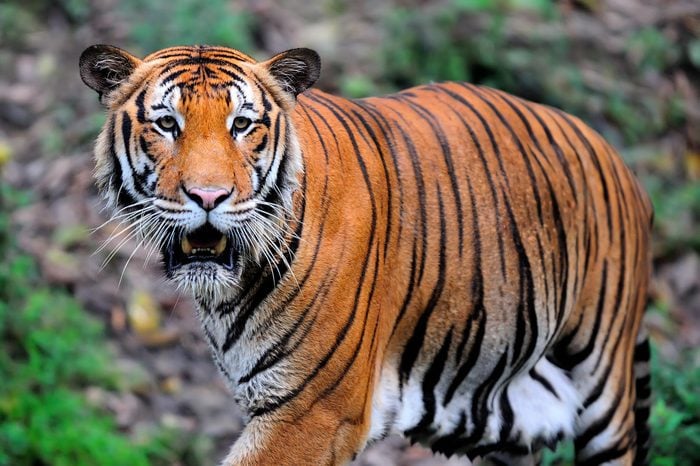
Malayan Tiger (Panthera tigris jacksoni)
This rare species is found only one place on Earth—the Malay Peninsula in southern Thailand, where only an estimated 200 of the cats remain. Tragically, China, which has traditionally used tiger bone for certain medicines, recently reversed a ban on the use of tiger parts; it’s a move that the WWF calls “an enormous setback for wildlife conservation.” Another: Tigers are often killed by Malayan villagers protecting their livestock; however, this is one area where WWF is concentrating its efforts and may see good results.
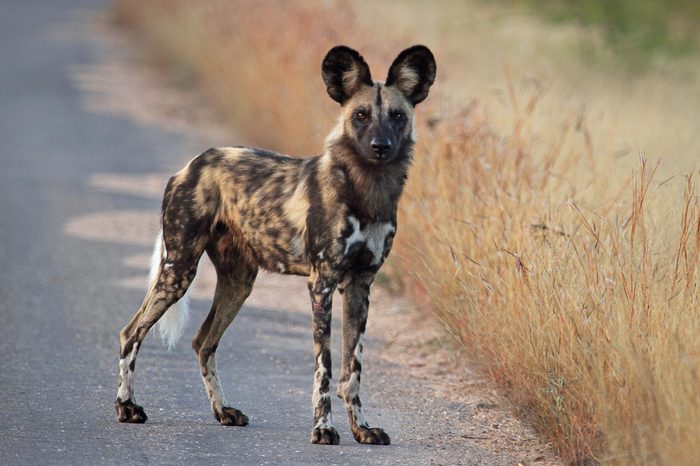
African wild dog (Lycaon Pictus)
These fast-running, critically endangered hunters of the African deserts and grasslands are down to paltry numbers—about 3,000 by most recent count. As with Malayan tigers, standoffs with livestock farmers have proved detrimental to their populations, but so have rampant diseases like rabies and distemper. They’re also rapidly losing habitat; conservation efforts are focused on connecting wildlife corridors to game preserves.
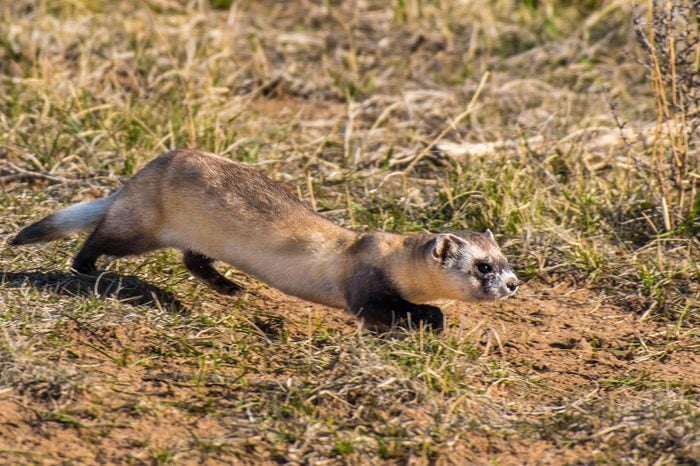
Black-footed ferret (Mustela nigripes)
Some good news for a change: This denizen of the Northern Great Plains of the United States, once thought extinct, has been given “a second chance for survival” thanks to multiple, decades-long conservation efforts (especially among tribal groups). Still, with numbers hovering around 350, it might be too soon to celebrate—especially since North America’s only native ferret species, which is prone to sylvatic plague, is also quickly losing habitat. Looking for more photos of America’s beauty? Here are spectacular photographs of America’s national parks that will leave you awestruck.
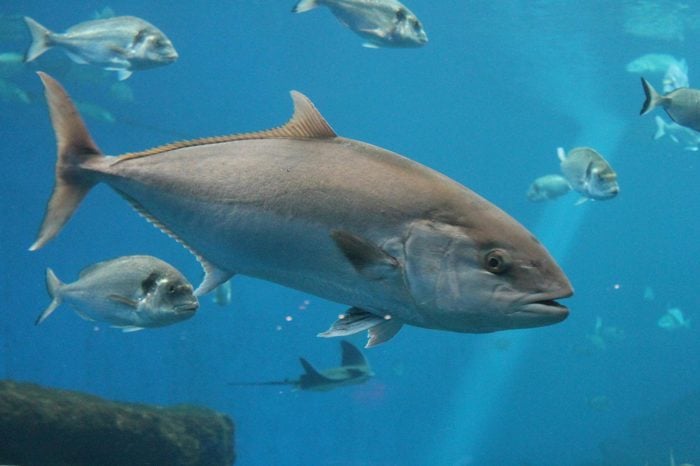
Bluefin tuna (Thunnus thynnus)
Call them victims of their own deliciousness; bluefin tuna have been fished to the point of near-annihilation—with Asia’s sushi demands a large contributor to their decline. And with tanking numbers have come inflated prices, which has led to an uptick in illegal fishing practices that have continued to decimate their stocks. This has made attempts to conserve what remains of these swift-swimming predator fish an uphill battle. Here are 14 wild animal species you never knew were endangered.
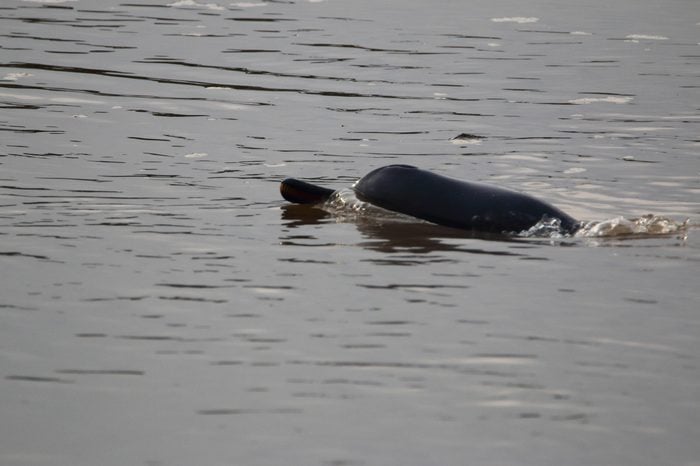
Ganges river dolphin (Platanista gangetica gangetica)
A blind freshwater dolphin native to India and Nepal’s ‘s severely degraded river systems, this ancient aquatic mammal is in serious trouble, perishing from chemical dumping, hunting, and starvation. The WWF monitors its populations, analyzes their various threats, and also works with local communities to introduce better conservation practices. Head to one of these 13 best places to see dolphins in the wild.
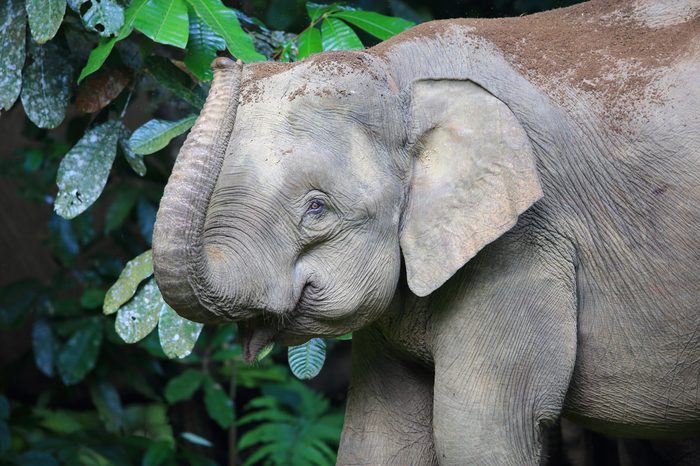
Borneo pygmy elephant (Elephas maximus borneensis)
They’re the smallest elephants in Asia, with a small—and dwindling—population of 1,500. Conservation organizations hope that China’s ivory ban will put a significant dent in the poaching of these and all elephants—although this will do nothing to minimize threats from increases in palm oil plantations throughout the region. Efforts are afoot to increase the wildlife corridors these beloved and intelligent animals rely on as their foraging grounds.
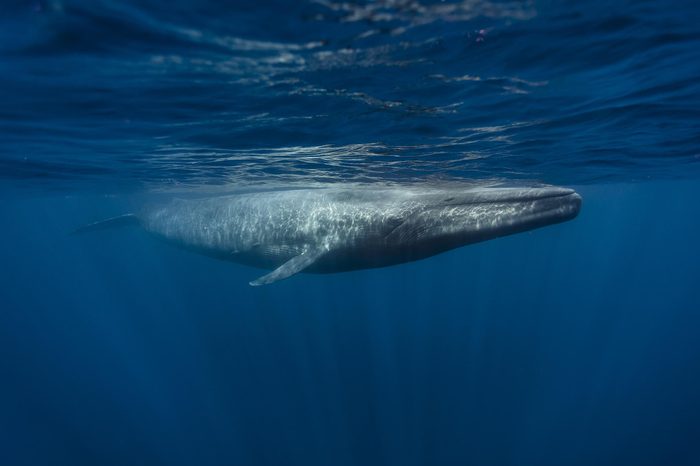
Blue Whale (Balaenoptera musculus)
It’s one of the most iconic animals in the world and it is quickly succumbing to warming oceans clogged with plastic and other pollution, and declining food sources thanks to climate change. Luckily, the pro-whale community is active and vocal, which means efforts to preserve the 10,000 to 25,000 blue whales estimated to still be swimming our global waters are strong and ongoing. The blue whale makes the list of the 23 largest living animals in the world.
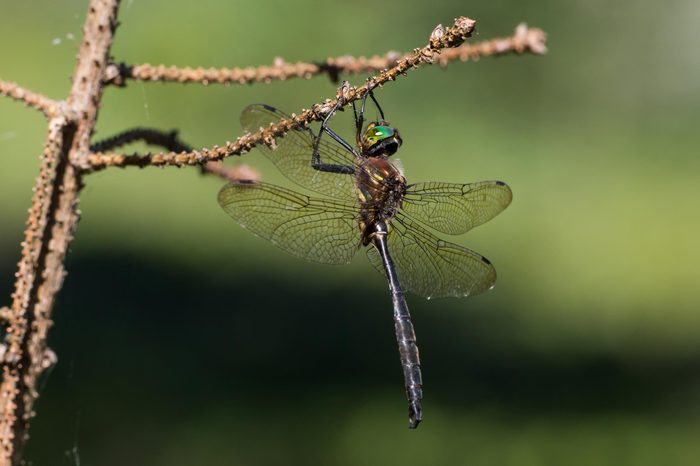
Hine’s Emerald Dragonfly (Somatochlora hineana)
Thought extinct in the mid-1900s, discovered anew in 1988, this iridescent green insect native to Illinois, Missouri, Michigan, and Wisconsin is in danger once again. Efforts to preserve the wetlands, marshes, and streams that are critical to its survival from invasive species are underway, as are proposals to limit dragonfly-killing speed limits for cars.
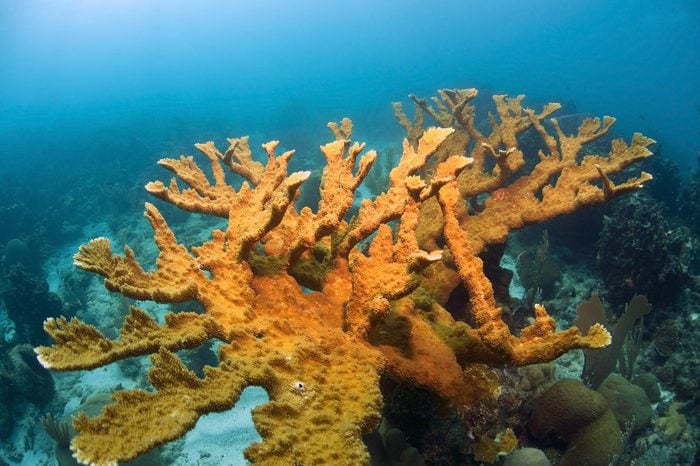
Elkhorn coral (Acropora palmata)
Coral reefs the world over are threatened by ocean acidification and warming, which are results of climate change. Here in the United States, the Center for Biological Diversity petitioned the National Marine Fisheries Service to put 83 species of coral on the Threatened and Endangered lists; as of 2015, 22 had been added as threatened—including reef-building Elkhorn coral (although the petition requested endangered status)—and three had been added as endangered. Many efforts persist worldwide to restrict harvesting, but tackling the effects of climate change will require enormous sustained and coordinated global efforts. Find out 15 places to visit before they disappear, including the Great Barrier Reef.
